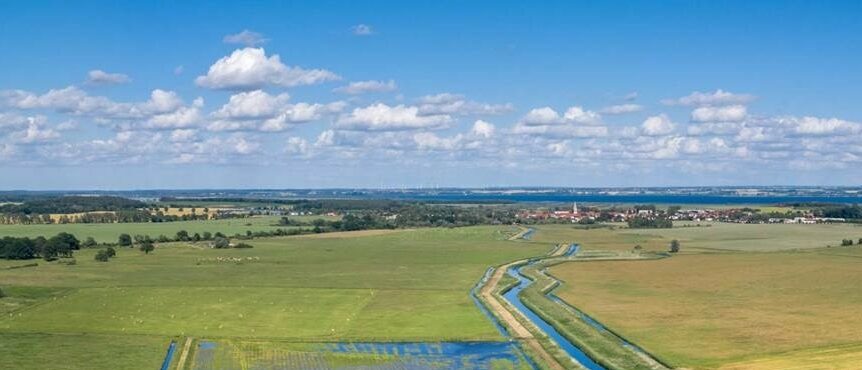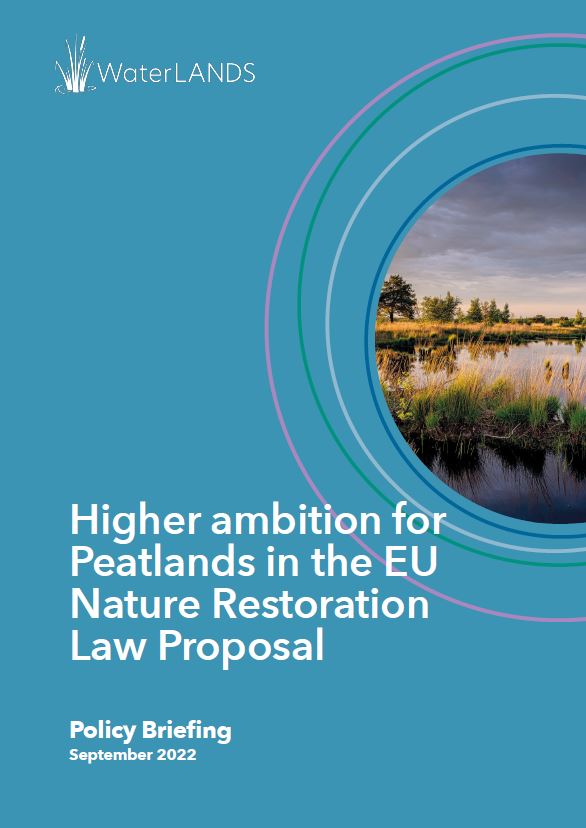
Higher ambition for Peatlands in the EU Nature Restoration Law Proposal – Briefing
On 22 June 2022, the European Commission presented its long-awaited proposal for a law to restore Europe’s degraded ecosystems, habitats and species. The draft law, though a positive development for European environmental policy, including on peatlands, has room for improvement. This briefing, drafted by Greifswald Mire Centre and Wetlands International Europe with the support of conservationists and scientists across Europe, outlines some of these improvements and calls on decision-makers to amend the proposed targets in line with a pathway that leads to net-zero CO2 emissions from peatlands by 2050.
The proposed Nature Restoration Law (NRL) features specific restoration targets for Europe’s degraded ecosystems, habitats and species, including wetlands, rivers, forests, grasslands and marine ecosystems. Importantly for the purpose of this briefing, the draft law includes a target to restore drained peatlands under agricultural use beyond peatlands listed in Annex I of the Habitats Directive 92/43/EEC (Art. 9 NRL proposal, see the end of this paper).
Peatlands outside protected sites, which have been drained and are currently used for agriculture, are just as vital for water storage and climate change mitigation and adaptation as protected ones. We welcome the recognition of the importance of peatlands for biodiversity and climate protection (recital 54, NRL proposal) and the mention of alternative modes of use such as paludiculture (wet agriculture and forestry on peatlands) (recital 55, NRL proposal).
The targets of the NRL proposal focus strongly on agriculturally used peatlands, while many peatland-rich EU Member States use peatland areas predominantly for land use types other than agriculture (namely forestry or peat extraction). These other land use types are hardly covered by the proposal, which leaves the peatland-rich Nordic and Baltic countries with fewer obligations to restore peatlands compared to the other Member States, despite their large share of drained peatland areas. As it stands, Article 9.4 thus creates an imbalance in the NRL’s ambitions in light of the need for peatland restoration, thus its scope should be extended to other types of land use.
The proposed Article 9.4 differentiates between restoration and rewetting. The overarching objective of the law is “to contribute to the continuous, long-term and sustained recovery of biodiverse and resilient nature […] and to contribute to achieving Union climate mitigation and climate adaptation objectives and meet its international commitments” (see general objectives of the proposed regulation). Climate objectives – clearly – cannot be reached without full rewetting.
RECOMMENDATIONS
Peatlands occur in almost all EU Member States (see figure 1), with a concentration in North-western, Nordic and Eastern European countries, covering an area of approximately 350,000 km2, of which more than 50% are degraded by drainage and used for agriculture, forestry and peat extraction.
EU Member States, above all peatland-rich ones, need to take clear responsibility and commitment to restore (i.e. fully rewet) and safeguard peatlands. EU Member States, landowners, and land-users in the EU should be encouraged and incentivised to maintain and re-establish high water levels in peatlands to maximise carbon storage, minimise GHG emissions, and support biodiversity, we call on EU decision-makers to ensure that:
- Rewetting is a prerequisite of peatland restoration
Article 9.4 proposes separate targets for restoration and rewetting of peatlands, but this distinction is inaccurate. Restoring degraded peatland requires improving hydrological conditions, first and foremost by rewetting. We recommend deleting the separate rewetting target, and making rewetting a condition for any restoration target.
- The proposed targets are insufficient and should be increased significantly
A higher ambition for drained peatland targets is therefore needed for consistency across policies and to prevent drained peatland from remaining a huge source of carbon losses in the AFOLU (agriculture, forestry and land use) sector.
- The scope of the target is expanded to all non-residential land use on drained peatland
The focus on drained peatland under agricultural use prioritises the GHG emission hotspots but largely neglects other land use types such as drained peatlands used for forestry, which urgently need to be rewetted as well. Several peatland-rich Member States (especially Nordic countries) have only a small share of agriculturally used peatlands. The proposed targets imply disproportionally low rewetting ambitions for those countries.
All countries should be equally ambitious in peatland rewetting, regardless of the type of use. Therefore, the scope of the Article 9.4 should be expanded to all types of peatland use. The targets need to be formulated for “organic soils constituting drained peatlands under any land use, except for residential areas”.
- A mandatory monitoring for peatlands restoration is set in Article 17
Art. 17 requires the Member States to monitor almost all ecosystem types except peatland restoration on drained organic soil and this omission should be rectified. Member States should be held accountable for their use of peatlands, so mandatory monitoring of peatland restoration is essential for the proper implementation and enforcement of the law. EU-funded research projects such as WaterLANDS, ALFAWetlands, WETHorizons, Rewet, ReVersal and PRINCESS are building the science base to which the Member States can contribute further.
NOTES
This policy brief was jointly produced in September 2022 by Greifswald Mire Centre and Wetlands International Europe.
For the list of the scientific institutions and conservation organisations supporting this paper, please refer to the briefing.


